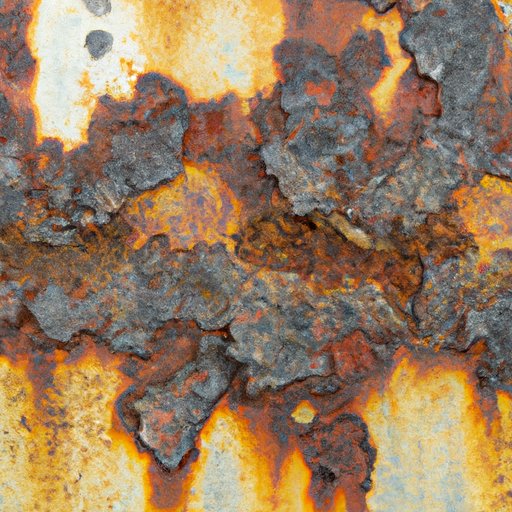Introduction
Rust is a common phenomenon that affects metal surfaces, particularly iron and its alloys. Rusting is also a major problem as it not only affects the integrity and strength of a metal surface but also takes away its aesthetic appeal. Understanding rust formation, prevention, and artistic usage are all essential for anyone looking to keep their metal surfaces in tip-top condition. In this article, we explore the different aspects of rust, including the science behind its formation, rust prevention techniques, and its impact on our health and cultural heritage.
The Science Behind Rust: Understanding How It’s Formed and Its Effects.
Rust formation is a chemical reaction that occurs when iron or its alloys come into contact with oxygen and water. The reaction causes the formation of a reddish-brown hydrated iron oxide that weakens the metal over time. The process of rust formation is an electrochemical reaction where electrons are transferred from the iron to create an iron oxide that flakes and exposes fresh layers of metal for further reaction. Rust formation can take various forms, including red rust, white rust, and black rust.
The effects of rust can be significant, depending on the type of metal and the location of the rusting. Rusting can cause a metal object to weaken, lose its structural integrity, and discolor. Rusting can also negatively impact the functionality of machinery parts and electrical components. Some metals rust more easily than others because they contain different alloys and properties; factors such as moisture, heat, and other environmental conditions can also affect the rate of rust formation.
Rust Prevention 101: Tips and Tricks to Keep Your Metal Surfaces In Tip-Top Shape.
Preventing rust formation is essential for maintaining the longevity and aesthetic appeal of metal surfaces. Several techniques can be used in rust prevention, including painting, galvanizing, and electroplating. Preparing surfaces properly through cleaning and rust removal before application is an essential step in any rust prevention process.
Regular maintenance is also essential for preventing rust formation. Keeping metal surfaces dry, free of debris, and well-oiled is a simple yet effective way of preventing rust formation. There are also various products in the market that can help prevent rust formation, like rust inhibitors, moisture absorbing packets, and rust converter sprays.
The Beauty of Rust: Exploring the Artistic Side of the Oxidation Process.
Rust can also be an aesthetically pleasing feature on metal surfaces, appreciated for its texture, colors and shine. Rust has practical applications in visual arts, industrial design, and architecture. Some artists even use rust as a medium to create unique works of art. They achieve various forms of rust art processes, including chemical alteration, etching, and electroplating. Examples of rust art can range from paintings on canvas to sculptures and ornaments.
How Rust Can Affect Your Health: The Dangers of Inhaling Rust Particles.
The inhalation of rust particles can have adverse health effects, particularly to those working in construction and DIY enthusiasts. Rust particles contain iron oxide, which can lead to lung irritation and other respiratory issues, including lung damage and tetanus. Severe rust inhalation can also result in a condition called pneumoconiosis that affects the lungs’ ability to exchange oxygen and can lead to respiratory failure.
Safety measures can be taken to avoid the inhalation of rust particles, including the use of personal protective equipment such as face masks, gloves and proper ventilation. Proper handling and disposal of rusty metals are critical for safe handling.
Rust and History: Discovering How the Element of Time is Reflected in Our Industrial Heritage.
Rust can also be a historical marker, indicating the age and lifespan of an object. The presence of rust on an object can tell a story, revealing details such as the type of metal used and the object’s manufacturing date. With corrosion, rusted objects may disintegrate, significantly affecting the story each object holds.
Preserving rusted objects is critical in maintaining their historical significance. Techniques for preservation might vary based on the object, but most require proper cleaning, rust removal, and protective coatings. Museums, historical societies, and restoration organizations often use a range of techniques to safeguard corroded objects and artifacts in their collections.
Conclusion
Rust formation and prevention are essential topics for anyone who owns or works with metal surfaces. Understanding the science behind rust, the impact on metal objects, and its potential dangers is key to keeping people safe and maintaining metal surfaces. Rust’s artistic applications and historical significance also make it a unique and intriguing subject that sparks creativity, research, and conservation.
With the right knowledge, tools, and techniques, rust can be managed, prevented, and appreciated while respecting its natural process.
